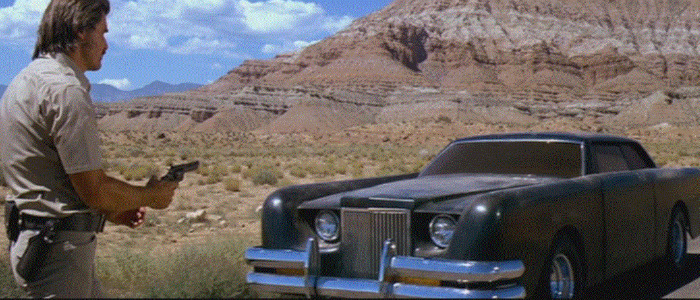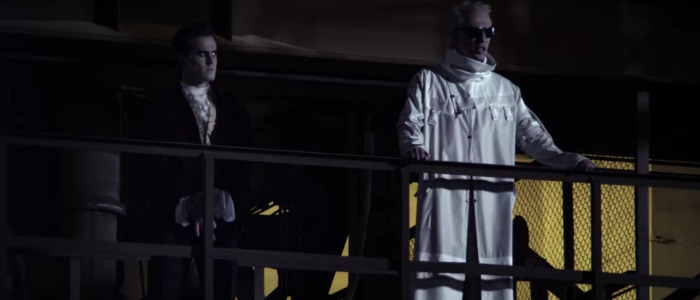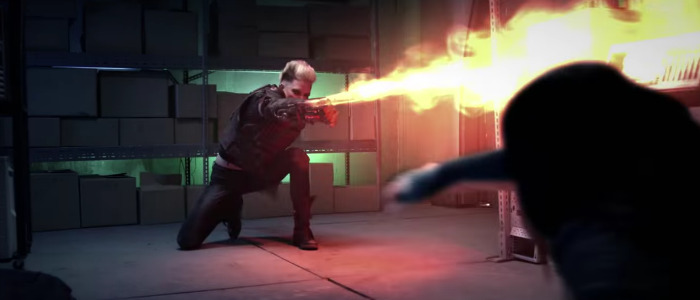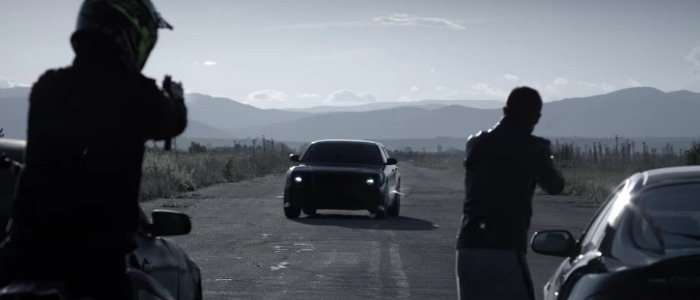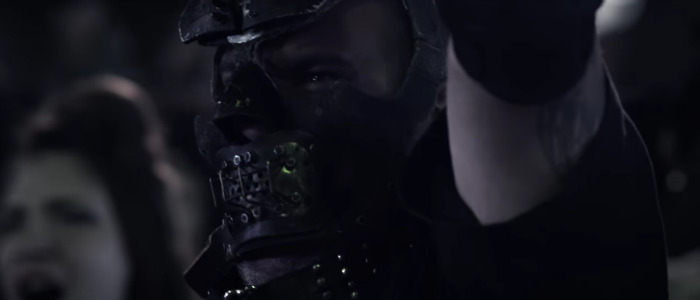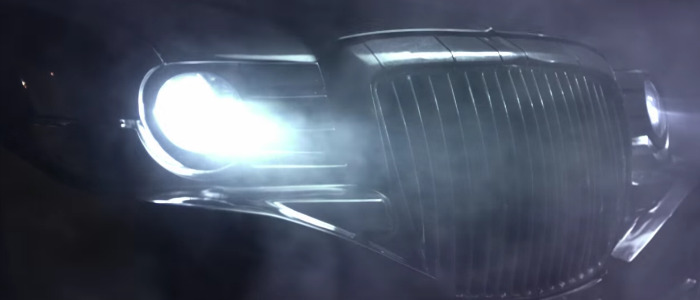'The Car: Road To Revenge' Isn't Quite The Sequel You're Expecting
(Welcome to DTV Descent, a series that explores the weird and wild world of direct-to-video sequels to theatrically released movies. In this edition, we take a road trip with a stylized sequel to a cult favorite horror flick.)
Some sequels feel like no-brainers while others make no sense at all, and then you have something like The Car: Road to Revenge... which hits both of those extremes at ninety miles per hour.
On the one hand, 1977's The Car is a fun little horror romp about a killer car mowing people down in a small western town. It's not fancy or all that impressive necessarily, but it's a good time at the movies. The film knows exactly what it is – a land-shark blend of both Duel and Jaws – and it embraces the horror and thrills of it all. It has become something of a cult favorite over the forty-two years since its release, and as it ends with the car prowling the streets of Los Angeles a sequel always felt like a possibility.
But no one could have expected this. Keep reading for a look at the self-proclaimed "stylized sequel" to The Car.
The Beginning
Two bicyclists are chased by an ominous black sedan and driven off the road to their deaths. A horn-playing hitchhiker is run over by the same car a short time later. This small town's police force isn't used to such blatant brutalities, and when the sheriff is killed next it's up to Officer Wade Parent to stop the hulking metal beast from lowering his town's population any further. Suspicions arise as to who could be driving the car, but when an old Navajo woman suggests there's no one behind the wheel all hell breaks loose. The car growls, honks its horn, and even drives through a house – a scene that clearly went on to influence 1984's awesome killer pig movie Razorback – before the acting sheriff and the other townspeople finally end the carnage. Get it? Carnage. Anyway, they bury the son of a bitch and watch as a giant demonic face appears in the smoky cloud above.
The DTV Plot
It's the future, Blade Runner on a non-existent budget, and violence fills the neon-lit streets. A district attorney guilty of his own crimes of grift and bribery pushes for stiffer penalties and quicker executions for the "real" criminals. How quick? A man is convicted in court, a tube drops over his body, and he explodes within. So, yeah, pretty quick. A local gang murders the D.A. in pursuit of an encryption chip, but when his body plummets from his office window onto his new car's hood his blood slips into its cracks bringing the vehicle to angry life. It begins seeking out and killing the gang members. Can rogue cop Rainer stop it? And more importantly, does he even want to?
Talent Shift
A surly James Brolin fights off the devil's wheels in The Car, and he's joined by a roster of familiar faces in supporting roles including Ronny Cox, R.G. Armstrong, John Rubinstein, Kathleen Lloyd, Kim Richards, and more. Brolin's no stranger to genre fare with films like Skyjacked (1972) and Westworld (1973) on his resume, and two years after this film he faced off against Satan once again in The Amityville Horror (1979). Director Elliot Silverstein also dabbled in horror (Nightmare Honeymoon, 1974) before strapping in for The Car, but he's better known for a pair of westerns – Cat Ballou (1965) and A Man Called Horse (1970). The film has three writers, and while that's often a bad sign you'd be hard-pressed to argue with their filmographies which include favorites like The Gauntlet (1977), Code of Silence (1985), Pale Rider (1985), and more. These are some fun genre efforts, and they also wrote my beloved slice of Canuxploitation Murder By Phone (1982)!
The sequel also stars some people you might recognize including a returning Ronny Cox and TV veteran Grant Bowler. Director/co-writer G.J. Echternkamp and co-writers Michael Tabb and Matt Yamas***a aren't as lucky with the most notable film between them being 2017's Death Race 2050. That's very fitting, and we'll get to why below.
How the Sequel Respects the Original
Well, there's a car. And it's killing people. It's unfortunately the DA's possessed sports car for most of the movie, but – spoiler! – the original 1971 Lincoln Continental Mark III black coupe returns for the third act. (Or at least a reasonable facsimile of one anyway...)
As with the original, we do also get one pretty spectacular car kill, and while it's not quite on par with the drive through the walls and rooms of a house it is guaranteed to leave a smile on your face. A bounty is declared on the killer car – don't ask – leading all manner of Mad Max-like rejects to chase after it. They set up a roadblock complete with guys standing up through the roofs to fire mounted machine guns, but the car is one step ahead. It races towards them and takes a sharp turn that sends it into the air and a barrel roll decapitating them as it goes. It's ridiculous and something the film needs far more of. There are a few bloody kills via non-car weapons, and they help make the film a passable watch for dedicated viewers with low bars and/or high thresholds.
How the Sequel S***s on the Original
The original movie is a straightforward Jaws riff with a supernatural bent as a large, fast-moving killing machine arrives in town with no explanation, proceeds to slaughter locals and spread terror, and is then itself killed by a cop and others. The lack of reason and motivation raise the horror and suspense as anyone can bite it at any time. Even the suggestion that the car's motivation was powered by hell itself is left more than a little open-ended. Road to Revenge eschews all of that and instead gives us an even simpler revenge setup devoid of suspense or mystery – a guy is murdered and is now out for revenge as a slick, self-driving automobile. It lacks an interesting hook in its main plot and instead becomes just another generic tale.
Narrative aside, what's the appeal of this near-future setting? Trick question, there is none. While the original dropped viewers into a familiar town with recognizable characters and relationships, the sequel lays a dark digital filter over it all while offering cheap evidence of the future in holograms, minor gadgetry, and gang members you will only find in low-budget post-apocalyptic fare. Seriously, the tough guys here consist of a cyborg, a cowboy, a punk, a guy dressed like 1980's Adam Ant, another who constantly combines his A Clockwork Orange/Flavor Flav cosplay outfits, and their boss – a British surgeon with white eyes and a habit of forcing biological/mechanical mods onto people.
Far too much of the film is focused on their antics and efforts to retrieve the encryption chip as well as making it clear the D.A. is a bit of a prick himself. He calls poor people "filth" and tells his ex he won't stop coming for her until she's his again. Still, after he dies he actually saves her twice, in the form of the car which lowers its windows afterward to blare a love song, but that makes the killer car a force of good which is definitely not what the original film delivered. Granted, we also get a few bloody demises via both practical and CG bloodwork including an eye-catching head pop, some tactically trained female assassins, a girl fight, villains in top hats with southern drawls, a woman with flame-thrower gloves, a guy with a finger drill... and the return of Ronny Cox, albeit as a different character, who finally brings the original car into the mix to draw a single tenuous connection to the earlier movie.
Conclusion
Per the Death Race 2050 mention above, The Car: Road to Revenge feels like it was filmed in between camera setups of that direct to video stinker. To be clear, it wasn't, as the former was filmed in Peru and the latter in Bulgaria, but the feel of the film's world is very much the same. It's rundown in a way that screams set availability rather than artistic design, the performances are exaggerated for effect, and the focus seems more on car action and topless strippers than on creating an engaging story or characters. It not only lacks the horror of the original but it never even aims for it, so fans of the earlier movie should probably avoid this one – unless you're also a fan of choppy car action, CG shenanigans, and Ronny Cox.

